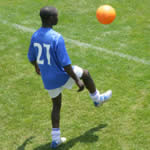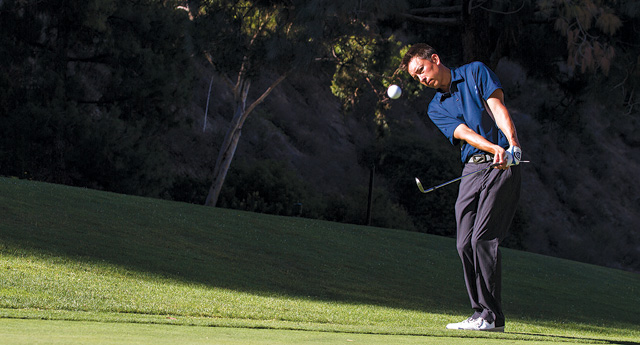roughing the kicker
Question
if a punter is using the rugby style to punt does he lose the
punter protection
Answer
Dee
Thanks for your question.
The brief answer is Punter who run outside of the tackle box lose protection from roughing or running into the kicker. If it is not obvious a kick will be made there is no protection. The rule under NCAA rules was simplified in 2009. So the key is the kicker's position within the tackle box.
If the rugby style kicker is to run toward the line of scrimmage or runs wide of the formation he loses his protection because he becomes a runner at that time. It would place the defense at a disadvantge to give the rugby style kicker so much continuing protection that the defense could not tackle the player as he runs with the ball and treatens for more yardage.
Please know the High School - Federation rule does not reference a tackle box and the kicker has protection while in th eact of kicking. With that said I must give you a detailed answer and analysis of the rule.
The simple answer to your question is that a rugby style kicker "may" loose his protection as a kicker and be afforded the same protection as a runner/ball carrier. He does not authomatically lose the protection of a kicker if he is in an obvious scrimmage kick formation and only takes a step or two. Kickers who run outside of the tackle box lose protection from roughing or running into the kicker. However, the are subject to the normal personal fouls protection for all players.
The simple way to understand roughinh the Kicker is to understand that a Kicker who is in the act of kicking or has just completed a kick and he has not yet regained his position with both feet firmly on the ground (not yet reasonable time to regain his balance) gets special protection as a Kicker.
A punter who is running with the ball and it is not obvious he is about to kick the ball or that a kick is imminent does not get special protection as a kicker - he gets the same protection as any runner [ball carrier].
In your play the punter is a rugby style kicker. While running he is a runner and not a kicker and he can be tackled, blocked, etc. As the runner "pulls up to punt the football" you start to get into a very Gray or subjective area. It is at this point the player's designation may begin to change from runner to kicker. If it is obvious he is about to kick and is starting the act or process of kicking the ball, then he becomes a kicker.
In 2009 the NCAA Rule was changed to make reference to a "TACKLE BOX" and if the kicker was outside the Tackle box he then loses protection as a kicker but not protection from other personal fouls or unnecessary roughness. The NCAA Rule Book used the following example: Kicker A1, in a scrimmage kick formation, moves laterally two or three steps to recover a faulty snap,or recovers a snap that went over his head and then kicks the ball. He is contacted by B2 in an unsuccessful attempt to block the kick. RULING: A1 does not automatically lose his protection in either case unless he carries the ball outside the tackle box. While in the tackle box A1 is entitled to protection as in any other kicking situation. When it becomes obvious that A1 intends to kick in a normal punting position, defensive players must avoid him.
On these plays where the punter runs and kicks or does a rugby style run and kick the window that affords the player the special protection is limited. If he is outside the Tackle box or normal position of the tackles he then loses the protection and this gray area in the rule becomes Black & White.
If the punter who is in the tackle box, is "tackled just as he is punting" his rugby style kick, he is in the act of a scrimmage kick (punt) therefore he is given the protection afforded a kicker. If he is tacked just as the ball leaves the kicker's foot, the would still be afforded the protection. Thus the tackle is likely a personal foul for Roughing the Kicker If he is outside the tackle box then there would be no foul.
The NCAA rule (Rule 9-1-4 governing Roughing or Running Into Kicker or Holder) states:
When it is obvious that a scrimmage kick will be made, no
opponent shall run into or rough the kicker or the holder of a place kick.
1. Roughing is a personal foul that endangers the kicker or holder.
2. Running into the kicker or holder is a foul that occurs when the
kicker or holder is displaced from his kicking or holding position but is not roughed.
3. Incidental contact with a kicker or holder is not a foul.
4. The kicker and holder must be protected from injury, but contact
that occurs when or after a scrimmage kick has been touched is not
roughing or running into the kicker or holder.
5. The kicker抯 protection under this rule ends:
(a) When he has had a reasonable time to regain his balance or
(b) When he carries the ball outside the tackle box (Rule 2-34) before kicking.
6. A defensive player legally blocked into the kicker or holder by a
member of the kicking team is not exempt from fouls for running into
or roughing the kicker or holder. A defensive player illegally blocked into the kicker or holder by a member of the kicking team is exempt from fouls for running into or roughing the kicker or holder.
7. When a player, other than one who blocks a scrimmage kick, runs
into or roughs the kicker or holder, it is a foul.
8. When in question whether the foul is 搑unning into抩r 搑oughing,拻
the foul is 搑oughing.拻
The PENALTY桭ive yards from the previous spot for running into the
kicker or holder. 15 yards from the previous spot and a first down for roughing the kicker or holder if the first down is not in conflict with other rules. Flagrant offenders shall be disqualified.
A kicker or holder simulating being roughed or run into by a defensive player commits an unsportsmanlike act.
The official NCAA rules interpretation under AR 9-1-4 provides the following example:
I. A1 catches a long snap and plans to punt from behind his line of
scrimmage but misses the ball, which falls to the ground. A1 is then
contacted by B1. RULING: Team A fumble. There is no kicker until
the ball is kicked, so B1 is not guilty of roughing the kicker.
II. A1 kicks the ball, after which B1, unable to stop his attempt to block the kick, runs into the kicker or holder. RULING: Penalty桭ive
yards from the previous spot. Roughing and 15 yards and first
down if in question as to whether the foul is 搑unning into拻 or
搑oughing.拻
III. A1, from a nonscrimmage kick formation, makes a quick, unexpected kick so suddenly that B1 cannot avoid contact. RULING: This is not roughing or running into the kicker since the rule applies only when it is reasonably obvious that a kick will be made.
IV. B1 runs into player A1, who has kicked the ball and has had a
reasonable time to regain his balance. RULING: Not a foul by B1
unless ruled as running into or throwing himself against an opponent
obviously out of the play (Rule 9-1-2-j).
V. After B1 runs into the kicker, kicker A25 simulates being roughed.
RULING: Offsetting fouls.
VI. Kicker A1, in a scrimmage kick formation, moves laterally two or
three steps to recover a faulty snap, or recovers a snap that went
over his head and then kicks the ball. He is contacted by B2 in
an unsuccessful attempt to block the kick. RULING: A1 does not
automatically lose his protection in either case unless he carries the ball outside the tackle box. While in the tackle box A1 is entitled to protection as in any other kicking situation. When it becomes obvious that A1 intends to kick in a normal punting position,
defensive players must avoid him.
VII. Punter A22 is 15 yards behind the neutral zone when he catches
the long snap, sprints to his right at an angle toward the line of
scrimmage, and runs outside the tackle box. He then stops and
punts the ball, and is immediately hit by a diving B89. RULING:
Legal play, no foul by B89. A22 loses his roughing or running-into
protection by carrying the ball outside the tackle box.
Here are some other plays to consider to illustrate what is and isn't roughing the kicker:
VIII Fourth and 10 at the A-10. A33 is in deep punt formation to receive the long snap. (a) A33 receives the snap, carries the ball outside the tackle box and (i) kicks the ball rugby-style on the
run or (ii) establishes himself as a kicker and punts the ball in the normal fashion. (b) A33 muffs the ball which goes outside the tackle box, where he recovers, establishes himself as a kicker, and
punts the ball in the normal fashion. In all cases end B80 dives and crashes into A33抯 plant leg immediately after the ball is kicked. RULING: (a) In both (i) and (ii) there is no foul for roughing the kicker because A33 carries the ball outside the tackle box before kicking. (b) Foul by B80 for roughing the kicker. A33 did not carry the ball outside the tackle box. First and 10 for Team A at the A-25
IX. Fourth and 10 at the A-10. A33 is in deep punt formation where he receives the long snap, carries the ball outside the tackle box and kicks the ball rugby-style on the run. After the ball is
away and as A33 is regaining his balance, B88 launches and drives the crown of his helmet up under A33抯 facemask.
RULING: Not roughing the kicker. Personal foul by B88 for targeting
and initiating contact against a defenseless opponent. First and 10 for Team A at the A-25.
I hope this explains the situation for you.
Victor Winnek
NCAA Football Official
illiegal formation
legal backwards pass


